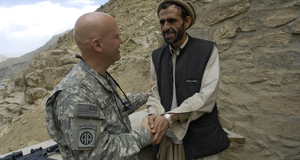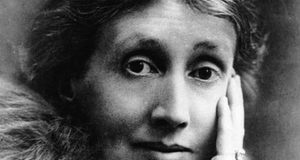Absurdism in Post-Modern Art: Examining the Interplay between "Waiting for Godot" and "Extremely Loud and Incredibly Close"
By
2009, Vol. 1 No. 11 | pg. 1/2 | » Post-modern art is permeated by Absurdism. The Post-World War II Absurdist movement centered on the idea that life is irrational, illogical, incongruous, and without reason (Esslin xix). The ‘Theater of the Absurd’, named by theater critic Martin Esslin in his 1961 work, was popularized by Samuel Beckett’s play, Waiting for Godot, Absurdist playwrights, Eugene Ionesco and Arthur Adamov. Political turmoil, scientific breakthrough and social upheaval shaped the cultural context of their works. Absurdist playwrights commented on the decline of moral character that the rise of fascism, WWII, and the Holocaust illuminated. The philosophical concept of existentialism (articulated most famously though the words of Kierkegaard, Heidegger, Sartre and Camus) influenced the ways in which Absurdist playwrights literally questioned the nature of existing. Waiting for Godot signified the beginning of a dramatic movement that continues to provide insights about the post-modern world even outside the lexicon of drama. The thoughts cultivated by Samuel Beckett and other early Absurdist writers are relevant in the post-modern world. In the novel, Extremely Loud and Incredibly Close, for instance, Jonathan Safran Foer utilizes Absurdist rhetorical techniques, structures and themes to convey aspects of ‘Theater of the Absurd’ in the Post-Modern literary world. To understand the absurdism present in Extremely Loud and Incredibly Close, one must understand the linguistic and culturally constructed origins of the term ‘Absurd.’ The term is used to describe the nonsensical, irrational aspects of life. As a movement, Absurdism attempts to formulate a method of rationalizing those irrational aspects in such an uncertain world. An Absurdist drama questions the significance of an individual’s role in his or her own life and the relative importance their actions make on the world at large. Absurdists focused on the irrationality of life and the impeding ‘post-life’ or ‘afterlife.’ Ionesco, an Absurdist playwright defined ‘absurd’ as, “ That which is devoid of purpose….Cut off from his religious, metaphysical, and transcendental roots, man[sic] is lost; all his actions become senseless, absurd, useless(Esslin xix).” Absurdism captured the sentiment of the nineteen-forties in its isolated conception of humanity.While the Absurdists found life, or existence, to be absurd they simultaneous found the lack of existence, death, or the idea of an ‘afterlife’ to be just as irrational. Through the idea that both existing and ‘not-existing’ will lead to the same end, the individual interprets their actions as pointless and absurd; the concept of existence is intangible and the act of existing cannot be authentic. As the world saw itself undergo catastrophic internal changes existence began to seem absurd and the plight of the individual futile. The historical context in which ‘Theater of the Absurd’ sprung from drew from the social, political and economic changes and issues of the World War II era. The rise of fascism, the horrors of WWII and the Holocaust inspired the philosophical concept of existentialism by highlighting the insignificance of an individual’s actions. These events illustrated how the purpose of an individual was to be utilized as a pawn in political schemes for the benefit of a high power; the individual themselves would therefore have no inherent or egoistic purpose in existing. World War II saw over 52,100,000 deaths by its conclusion (Timeline). The invention and use of the first atomic bomb by the United States against Japan marked a shift to a further removed attitude towards the enemy and a lesser level of moral investment in war tactics. This profanation of morality was what existentialist thought attempted to address in its questioning of the changing perceptions of the significance of individual lives. The use of the atomic bomb showed human beings solely as statistical casualties to whose lives no grandiose purpose or meaning could be attributed. The attacks on Hiroshima and Nagasaki in 1945 leveled the cities and caused 80,000 and 70,000 deaths respectively (Timeline). The United States Government knew the war against Japan was already won (It was settled at the Potsdam conference on August 3, 1945) three days before the bombing of Hiroshima (Bird and Sherwin). This was an example of choosing to experiment with new technology even though there would be the moral implication of causing unnecessary human casualties. The increased prevalence of anti-Semitism, Adolph Hitler’s rise to power, the Holocaust, and the subsequent death of over 6 million Jews (Nuremberg), highlighted the global decline of moral character. The modern conception of absurdity holds a different set of moral values concerning the significance of individual human lives because of degradation of morality shown in World War II. This decline in morality shattered optimistic attitudes towards human nature, and questioned the belief that people have innately good intentions. Fundamentally, this excited a questioning of religion (specifically Western Christianity). The essential question was, because how could a rational god allow such atrocities to occur? The decline of the necessity for religion in modern and post-modern society holds its origin in World War II, “The decline of religious faith was masked until the end of the Second World War by the substitute religions if faith in progress, nationalism, and various totalitarian fallacies. All this was shattered by the war (Esslin xix).” World War II catalyzed the failure of religion in trying to explain the reason for existence; in conjunction with the ‘nationalism and totalitarian fallacies’ stated above, the failure of religion left the world with a perspective of the future categorized by death and destruction. Concurrently, the philosophical movement of existentialism, which questioned the meaning attributed to human action in relation to interaction within society, religion and politics became relevant in the discussion of Absurdist Theater in the post- World War II period. This discussion is centered on the idea that existentialism has a place in ‘Theater of the Absurd.’ Albert Camus wrote that the current state of the world cannot be rationally explained and this new phenomenon alienates ‘man.’ Camus writes, “[man] is an irremediable exile, because he is deprived of memories of a lost homeland as much as he lacks the hope of a promised land to come. This divorce between man and his life, the actor and his setting, truly constitutes the feeling of Absurdity (Esslin xix).” Here, absurdity and existentialism share the idea that man’s search for meaning is an exercise in futility because life is inherently meaningless and truth is only subjective. When Freiderich Nietzsche pronounced, “God is Dead,” he meant “the time has come to overcome man (Appignanesi146).” Nietzsche criticized how the modern world, and modern man, no longer held the need for a God. Together, the ideas of Camus and Nietzsche suggest that the concept of ‘God’ cannot be significant in a world in which the absurd is embraced; a belief in a God requires submission to the idea that there is a way of rationalizing existence. Absurdism rejects this idea and because the concept of ‘God’ cannot be negotiated with Absurdism religion can no longer has a place in society. This newly godless society defined by absurd qualities and existentialist tendencies was popularized by the works of Samuel Beckett. Beckett, an Irish writer, born on April 13, 1906, is characterized as an Absurdist playwright who addresses the global existential crisis set in place by World War II. His body of work is thematically linked by a sense of desperation and distaste with life. Existentialism had a heavy influence on Samuel Beckett and the literature he produced. The cultural context in which he wrote framed the theories that manifest themselves in his work. Beckett cites his “uneventful” childhood as significant in the formation of his character and literary perspective. He describes his childhood as happy but said that he had, “little talent for happiness (Bair 14).” This kind of statement was typical of Beckett who often “…juxtaposes images of a happy childhood with teasing hints of loneliness and unhappiness, and which concludes with what should be a positive statement undercut by the insertion of a tone of lurking, brooding melodrama" (Bair 14). Themes of isolation and loneliness can be found through his early education. He was dissatisfied with the methodology of education in the early nineteen-hundreds. At this time, both in school and at home, Beckett found discipline to be privileged over learning (Bair 25). Beckett continued his education at Trinity College in Dublin, where he studied modern languages, but found his real inspiration to come from his time spent studying and teaching in Paris (Bair 55). As a writer, Samuel Beckett functioned as an outsider and observer, chronicling his own distaste with existence as well as the distaste of others. A fellow student at Trinity commented on his character saying that “There was always a slight sense of remoteness about him, even as an undergraduate. I don’t think anyone then really knew him well. He simply was not what is called a “public character.” He seemed to be a man that everyone knew of but no one knew well (Bair 45).” This statement embodies the distant stance Beckett took to his work and personal life. One of Samuel Beckett’s greatest influences was his intellectual relationship with James Joyce. Beckett worked as a sort of research assistant to Joyce. In his work Beckett became familiar with and fascinated by Joycean rhetorical techniques and concepts. To Beckett, Joyce was considered one of the “greatest writers of the century if not of all time (Bair 93).” Joyce created an “ethical ideal” for Beckett who said that, “he [Joyce] made me realize artistic integrity (Bair 93).” Beckett underwent a period of psychological instability which led him to psychological analysis. From this analysis Beckett entered what is known as the “Siege in the room” period. From 1946-1948 he underwent a significant period of creativity which extended into the 1950’s and “marked his emergence as one of the most influential writers of the present century (Bair 346).” It was during this time that he wrote Waiting for Godot, the play (quickly categorized as Absurdist) that made him famous. The cultural state of the world at the time Waiting for Godot was first produced dictated its success, “ Europe was caught up in what have come to be political clichés: Iron Curtain, Cold War, Social Unrest, Political Upheaval, The nuclear age. Existentialism held sway in France and had attracted followers throughout the rest of the world. In the simplicity of Waiting for Godot, they found the complexity of the human condition (Bair 389).”Samuel Beckett’s Waiting for Godot, written between 1948 and 1949, was first produced on January 5, 1953 at the Théâtre de Babylone, a seventy-five seat theater in Paris, and directed by Roger Blin (Hall). The play itself focused on the absurdity of human existence. Beckett inherently critiques Aristotle’s poetics in his distorted use of character, degradation of language (diction) and lack of plot. The main characters, Vladimir and Estragon talk in circles for the entirety of the play discussing how they are awaiting the arrival of ‘Godot’ and are unsure if they are in the right place at the right time. The sense of time in the play is absent, he writes, “Time” Time! Will you not stop tormenting me with your cursed Time? One day we are born, one day we die… that’s how it is on this bitch of an earth (Terry).” Beckett’s rejection of Aristotelian ideals is further describes how he defined a play, “in terms of unity of stage time, stage space, and stage situation. In his utilization of stage space, he found himself tending more and more toward restriction of movement, because for him, ‘each actor has his own home on the stage (Bair 551).’” The characters as individuals are dispensable, even interchangeable( as the reader sees in the interchangeability of the names Estragon and Vladimir are sometimes called either Gogo or Didi and it is often unclear to the reader who is being addressed and by whom). The significance of the play lies in how Vladimir and Estragon wait for Godot who will never come, even though they seem to know he will not come. The characters will wait because there is nothing else to do and whatever they will meet is inevitable and therefore their actions do not matter. The setting of the play is bleak, not specific to a geographic location, date or time and has been coined a post-apocalyptic picture of existence. Beckett captured a sense of complete isolation and powerlessness in respect to the individual’s role in the world at large. Waiting for Godot continues to be relevant in the Post-Modern age. Martin Esslin, a theater critic wrote at the time of the production of Waiting for Godot: Today when death and old age are increasingly concealed behind euphemisms and comforting baby talk and life is threatened with being smothered in the mass consumption of hypnotic mechanized vulgarity, the need to confront man with the reality of his situation is greater than ever. For the dignity of man lies in his ability to face reality in all its senselessness: to accept it freely, without fear, without illusions- and to laugh at it (Esslin 316). Esslin’s idea is that man finds solace in the ability to face and rationalize the irrationality and ambiguity of existence through creating art to depict and comment upon the disingenuous state of existence. The political and social context of the post-modern world lends itself to analysis through inspecting the presence of absurdity. The contemporary writer, Jonathan Safran Foer’s novel, Extremely Loud and Incredibly Close, looks at post-911 American society through the eyes of a young boy entertaining his own existential crisis and quest to reconcile history.Continued on Next Page » Suggested Reading from Inquiries Journal
Inquiries Journal provides undergraduate and graduate students around the world a platform for the wide dissemination of academic work over a range of core disciplines. Representing the work of students from hundreds of institutions around the globe, Inquiries Journal's large database of academic articles is completely free. Learn more | Blog | Submit Latest in Literature |
















